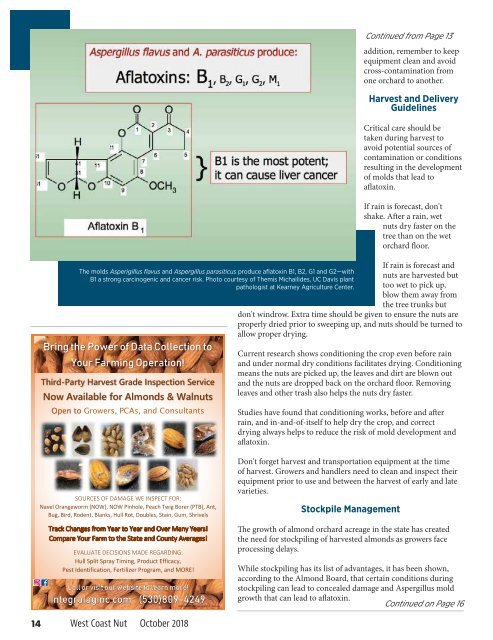You also want an ePaper? Increase the reach of your titles
YUMPU automatically turns print PDFs into web optimized ePapers that Google loves.
The molds Asperigillus flavus and Aspergillus parasiticus produce aflatoxin B1, B2, G1 and G2—with<br />
B1 a strong carcinogenic and cancer risk. Photo courtesy of Themis Michailides, UC Davis plant<br />
pathologist at Kearney Agriculture Center.<br />
Bring the Power of Data Collection to<br />
Your Farming Operation!<br />
Third-Party Harvest Grade Inspection Service<br />
Now Available for Almonds & Walnuts<br />
Open to Growers, PCAs, and Consultants<br />
Continued from Page 13<br />
addition, remember to keep<br />
equipment clean and avoid<br />
cross-contamination from<br />
one orchard to another.<br />
Harvest and Delivery<br />
Guidelines<br />
Critical care should be<br />
taken during harvest to<br />
avoid potential sources of<br />
contamination or conditions<br />
resulting in the development<br />
of molds that lead to<br />
aflatoxin.<br />
If rain is forecast, don't<br />
shake. After a rain, wet<br />
nuts dry faster on the<br />
tree than on the wet<br />
orchard floor.<br />
If rain is forecast and<br />
nuts are harvested but<br />
too wet to pick up,<br />
blow them away from<br />
the tree trunks but<br />
don't windrow. Extra time should be given to ensure the nuts are<br />
properly dried prior to sweeping up, and nuts should be turned to<br />
allow proper drying.<br />
Current research shows conditioning the crop even before rain<br />
and under normal dry conditions facilitates drying. Conditioning<br />
means the nuts are picked up, the leaves and dirt are blown out<br />
and the nuts are dropped back on the orchard floor. Removing<br />
leaves and other trash also helps the nuts dry faster.<br />
Studies have found that conditioning works, before and after<br />
rain, and in-and-of-itself to help dry the crop, and correct<br />
drying always helps to reduce the risk of mold development and<br />
aflatoxin.<br />
SOURCES OF DAMAGE WE INSPECT FOR:<br />
Navel Orangeworm (NOW), NOW Pinhole, Peach Twig Borer (PTB), Ant,<br />
Bug, Bird, Rodent, Blanks, Hull Rot, Doubles, Stain, Gum, Shrivels<br />
Track Changes from Year to Year and Over Many Years!<br />
Compare Your Farm to the State and County Averages!<br />
EVALUATE DECISIONS MADE REGARDING:<br />
Hull Split Spray Timing, Product Efficacy,<br />
Pest Identification, Fertilizer Program, and MORE!<br />
Call or visit our website to learn more!<br />
integralaginc.com (530)809-4249<br />
©2018 Integral Ag Inc. All Rights reserved.<br />
Don't forget harvest and transportation equipment at the time<br />
of harvest. Growers and handlers need to clean and inspect their<br />
equipment prior to use and between the harvest of early and late<br />
varieties.<br />
Stockpile Management<br />
The growth of almond orchard acreage in the state has created<br />
the need for stockpiling of harvested almonds as growers face<br />
processing delays.<br />
While stockpiling has its list of advantages, it has been shown,<br />
according to the Almond Board, that certain conditions during<br />
stockpiling can lead to concealed damage and Aspergillus mold<br />
growth that can lead to aflatoxin.<br />
Continued on Page 16<br />
14<br />
West Coast Nut October 2018


















